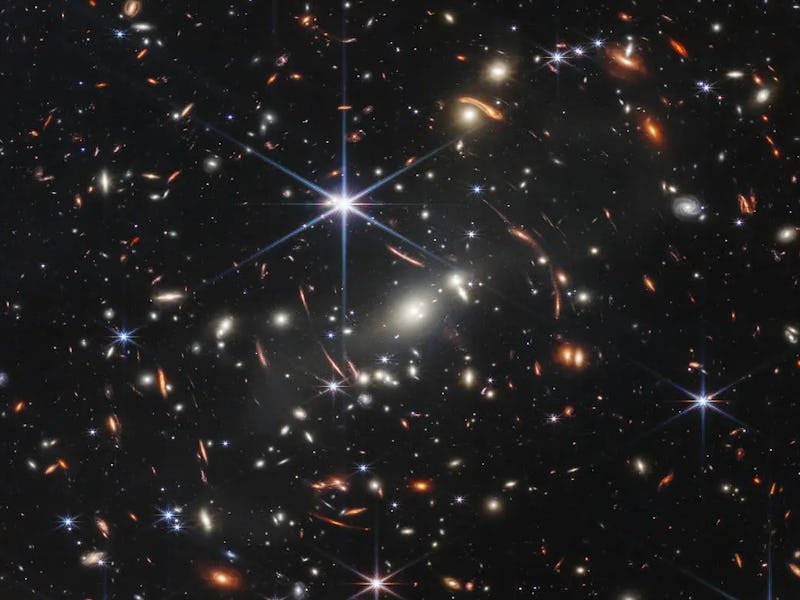This Early Galaxy Grew Inside Out And Upends What We Know About Star Formation
A recent study found a galaxy in the early universe busily forming new stars at its edges, not in the core.

Sci-fi tends to paint the edge of our galaxy as a desolate backwater, but in one early galaxy, the galactic rim is the bright, bustling center of activity, and the core is the aging backwater.
The James Webb Space Telescope (JWST) recently spotted a tiny galaxy in the early universe, more than 12 billion light years away, whose core was full of older, slowly fading stars; all the hot new star formation was happening out on the edges of the galaxy, not in the core, like a cosmic version of suburban sprawl and slowly-dying downtowns. The inside-out growth of this ancient galaxy could teach us something about the history of our own Milky Way and how it compares to the rest of the universe.
Cambridge University astrophysicist Sandro Tacchella and his colleagues published their work in the journal Nature Astronomy.
JWST’s sensitive instruments allow astrophysicists like Tacchella and his colleagues to view extremely distant galaxies in more detail than they could before.
The Outskirts of the Galaxy Are Where the Action Is
We tend to picture the universe’s earliest galaxies as vaguely round, reddish blobs of light, without much structure. But using JWST, Tacchella and his colleagues recently found one galaxy that, less than a billion years after the Big Bang, had already started evolving into something more complex.
“The question of how galaxies evolve over time is an important one in astrophysics,” says Tacchella in a recent statement. “By looking at different galaxies across cosmic time, we may be able to reconstruct the growth cycle and demonstrate how galaxies grow to their eventual size today.” That’s been one of JWST’s main science goals.
Like modern elliptical galaxies, this ancient one has a core densely packed with stars, which thin out toward the edges of the galaxy. JWST’s instruments measured the spectra of light shining from different areas of the galaxy, and Tacchella and his colleagues used that data to calculate the age and mass of the stars. It turns out that the dense galactic core is populated mostly by older, slowly fading stars, while most of the bustling new stellar neighborhoods are on the outskirts of the galaxy. And those booming galactic suburbs are growing fast enough to double the galaxy’s mass every 10 billion years.
(For comparison, our Milky Way is still growing, but much more slowly; we double our mass only every 10 billion years. The galaxy in Tacchella and his colleagues recent study is only one hundred thousandth the mass of our Milky Way, but it may eventually catch up.)
This image compares the size of Tacchella and his colleagues’ tiny galaxy to a modern elliptical galaxy from the nearby universe.
Galaxies in the more recent, nearby universe grow in a very similar way; as a galaxy grows, it’s gravity pulls in intergalactic gas from farther and farther away, and stars often form near the edges of galaxies where more of that gas is spiraling inward. Simulations predicted that ancient galaxies should have grown in the same way, but astronomers had never seen it happen. Instead, astronomers have only ever witnessed these early galaxies growing by colliding with each other in the crowded space of the early universe, violently merging into larger galaxies. But mergers don’t seem to happen often enough to account for how the little red blobs of light in the very early universe grew into today’s huge, complex spirals and disks of stars.
“Galaxy-galaxy mergers lead to the formation of a lot of new stars, and are therefore extremely bright and “easy” to find," Tacchella tells Inverse. "However, we think that these mergers are rare, and most galaxies grow by accreting fresh gas. However, we do not know this for sure, particularly [in the universe] at these early times.”
To understand more about how galaxies in the early universe grew and evolved into the ones we see today, Tacchella and his colleagues will need to watch the process happening in more than just one early galaxy. The team of astrophysicists is already analyzing data from several other galaxies, comparing the amount of new star formation that is in their cores and at their edges.
It’s possible that after a certain point in their lives, all galaxies tend to have aging, rundown cores and bright, fast-growing outskirts. But it’s also possible that galaxies alternate between forming new stars in their cores and in their outskirts — maybe depending on the supermassive black hole at the center of the galaxy or the amount of intergalactic gas available nearby.
“The problem is that we cannot observe this specific galaxy as it changes with cosmic time (we would have to wait millions of years!) so we have to study many systems and look for patterns,” says Tacchella.